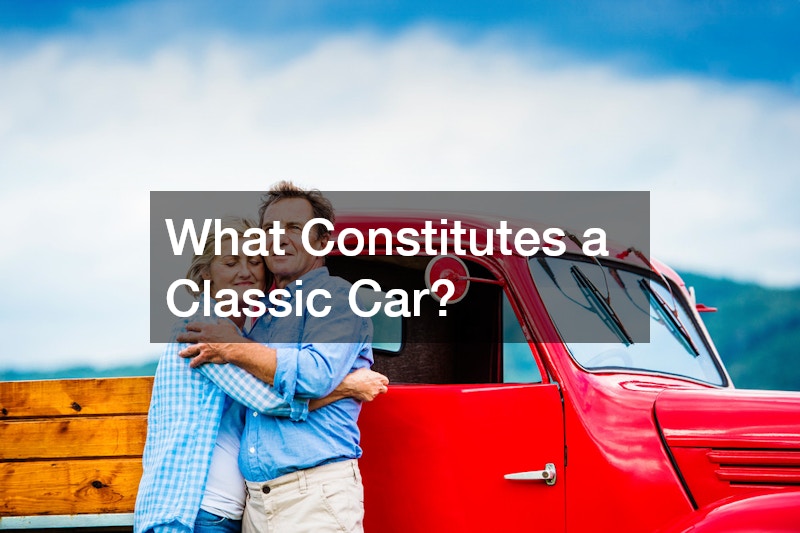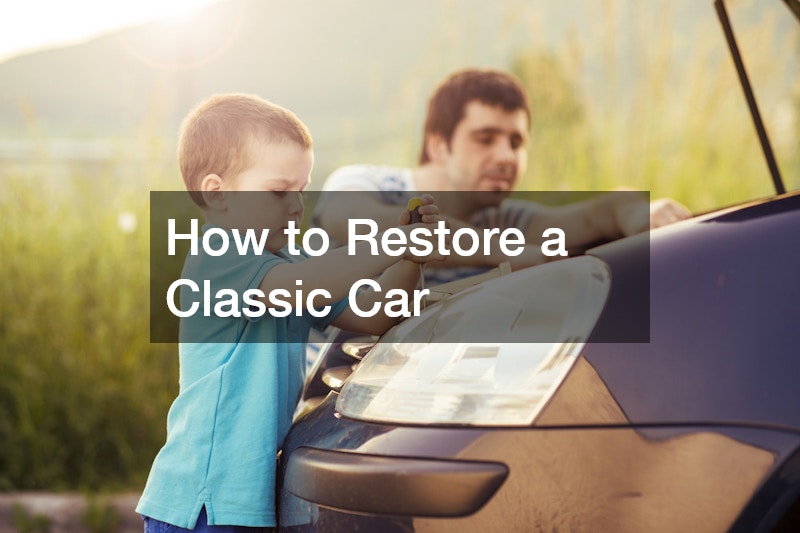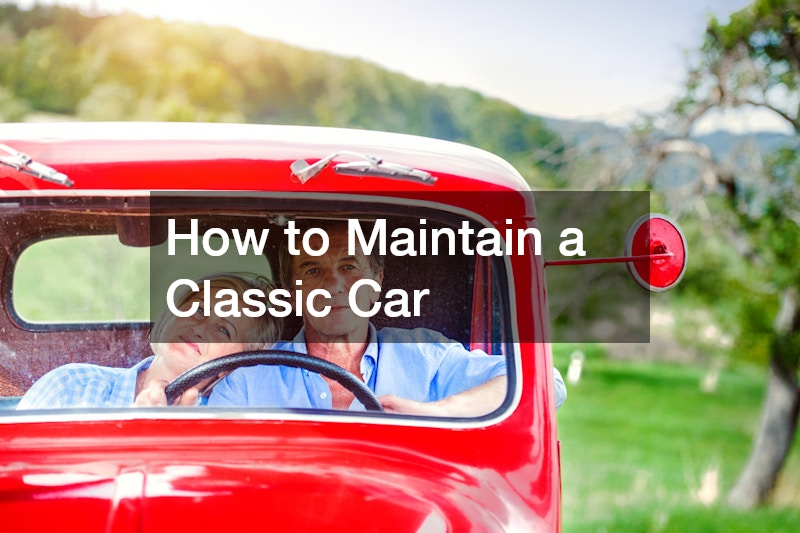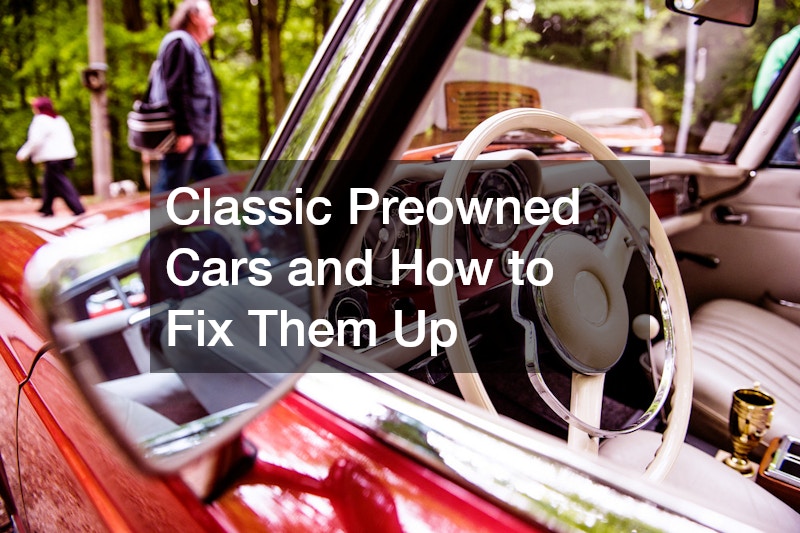
Classic cars have a charm that transcends generations. These vehicles, often referred to as “timeless beauties,” have distinct designs, unmatched craftsmanship, and a rich history that continues to appeal to car enthusiasts worldwide. For those who are passionate about cars, acquiring and restoring a classic preowned car can be both a rewarding project and a worthy investment. This article delves into the world of classic preowned cars and offers comprehensive advice on how to restore and maintain these automotive treasures.
What Constitutes a Classic Car?

Defining ‘Classic’ in Automotive Terms
A “classic preowned car” generally refers to a vehicle that is at least 20 to 40 years old and has significant historical or design importance. Unlike modern cars, which focus on efficiency and technology, classic cars often represent bygone eras of automotive innovation and style. They are revered not only for their distinctive looks but also for their ability to tell the story of an industry that evolved through craftsmanship and ingenuity.
These cars come in many shapes and forms—whether it’s a vintage convertible from the 1960s or a muscle car from the 1970s, each classic car has its own appeal. The “classic” status is often recognized by automotive organizations and enthusiasts alike, with some cars even gaining the honor of being labeled as collector’s items.
Age and Historical Significance
Age is a primary factor that helps define what makes a classic car. Generally, a car must be at least 25 years old to be considered a “classic.” However, historical significance also plays a role. Classic preowned cars were often part of landmark periods in automotive design or technological breakthroughs, making them symbols of a specific era. Whether it’s the sleek lines of a 1965 Mustang or the bold design of a 1957 Chevy Bel Air, these cars evoke nostalgia and have become pieces of history on wheels.
The Appeal of Classic Design
The visual appeal of classic cars is undeniable. Many of these vehicles were designed with curves, chrome, and a sense of boldness that modern cars can lack. Enthusiasts are often drawn to their unique aesthetic and the opportunity to drive a car that stands out from today’s more standardized vehicles. But beyond their looks, the mechanical simplicity and direct driving experience of classic cars offer something that modern, tech-heavy vehicles can’t replicate.
How to Find a Good Classic
Reputable Dealers and Online Marketplaces
When looking for a classic preowned car, knowing where to search is crucial. Reputable dealers and specialized online marketplaces are the best places to start your search. Many classic car enthusiasts often turn to local auto dealers that specialize in vintage models or to online platforms such as Hemmings, ClassicCars.com, and Bring a Trailer. These sources tend to provide accurate listings and detailed information, making it easier to find the right vehicle for your needs.
Whether buying from a local auto dealer or an online marketplace, ensure that the seller has a good reputation. Research reviews, check for certifications, and never be afraid to ask questions about the car’s history and current condition.
Understanding Vehicle History Reports
A detailed vehicle history report is essential when buying a classic car. These reports reveal the car’s past, including ownership history, any collision records, and title status. Given that many classic preowned cars have gone through multiple owners, ensuring the car hasn’t been involved in serious accidents or floods is crucial. Knowing the car’s service and accident history helps you gauge what repairs may be needed in the future and whether the vehicle has been well maintained over its lifetime.
Negotiating Purchase Prices
The price of a classic preowned car can vary widely depending on the car’s make, model, condition, and rarity. A key factor in the negotiation process is knowing the market value for the vehicle and being prepared to discuss the cost of potential restoration work. It’s not uncommon to negotiate lower prices if a car has cosmetic damage or mechanical issues. However, be prepared to pay a premium for rare or highly sought-after models that are in pristine condition.
What Are Common Issues with Classic Cars?
Engine and Transmission Problems
Engine and transmission problems are among the most common issues that owners face when restoring a classic preowned car. Given their age, classic cars may suffer from wear and tear that affects these critical components. Whether it’s an issue with the carburetor, gaskets, or gearbox, these vehicles need thorough inspections before being put back on the road. Performance cars, particularly those that were once used as racecars, might need even more attention due to the stress that high speeds can place on engines and transmissions.
Electrical System Failures
Electrical systems in classic preowned cars can be another common area of concern. The wiring in these vehicles may degrade over time, leading to shorts or failures in the car’s lighting, ignition, or radio systems. Modern electrical components may not be compatible with older cars, so owners often need to source vintage parts or find specialized mechanics who understand these outdated systems.
Body and Frame Integrity
Body and frame integrity is crucial when restoring a classic preowned car. Rust, corrosion, and dents are issues that frequently plague older cars. Thoroughly inspecting the body for damage, particularly the frame, will help you assess what type of repairs will be necessary. In some cases, specialized welding or part replacements may be required to restore the car to its former glory.
How to Restore a Classic Car

Creating a Restoration Plan
Before diving into the restoration of a classic preowned car, creating a clear plan is key. This plan should outline the steps involved, from sourcing parts to scheduling services like painting or car stereo installation . Research the specific model and determine which parts need replacement, which can be restored, and what custom work (if any) you’d like to do to make the car your own.
Finding and Sourcing Parts
One of the biggest challenges in restoring a classic car is finding the correct parts. Depending on the rarity of the model, parts may need to be sourced from specialized shops or online marketplaces. Another option is to search for parts at classic car swap meets or auctions. Many enthusiasts turn to forums or vintage part retailers to track down the parts needed for their projects.
Bodywork and Painting Techniques
Restoring a classic preowned car often involves extensive bodywork and painting. To achieve the right finish, many owners work with a local auto body shop that specializes in vintage cars. These professionals can repair dents, rust, and scratches and apply paint that matches the original color or a custom shade of your choice. Bodywork is one of the most labor-intensive aspects of a restoration project, but it is also one of the most rewarding, as it can completely transform the look of the car.
Interior Restoration Tips
Restoring the interior of a classic preowned car is as important as the exterior. Seats, dashboards, and carpets often need to be replaced or reupholstered. Modern technologies like GPS tracking systems can be discreetly installed for security, while upgrades like car stereo installation can enhance the driving experience. Working with a skilled car detailer is often beneficial for restoring the interior to a showroom finish, ensuring that even the smallest details are cared for.
Which Tools and Equipment Are Essential?
Basic Repair Tools
Restoring a classic requires a set of basic tools that every car enthusiast should have. This includes wrenches, screwdrivers, pliers, and socket sets. While these tools are essential for most repairs, more complex projects may require specialized equipment.
Specialized Equipment for Classic Cars
For more intricate restoration tasks, such as engine overhauls or bodywork, specialized equipment like hydraulic jacks, sanders, and paint guns may be necessary. Certain models of classic cars might also require specific tools for brake adjustments or carburetor tuning.
Recommended Brands for Quality Tools
When restoring a classic preowned car, it’s important to invest in high-quality tools. Trusted brands such as Craftsman, Snap-on, and DeWalt offer durable tools that are known for their reliability, precision, and strength. Having the right tools at your disposal makes the restoration process smoother and more enjoyable.
Can Classic Cars Be Converted to Electric?
Understanding Hybrid and Full Electric Conversions
As electric vehicles become more popular, some classic car owners are exploring the possibility of converting their vehicles to electric or hybrid models. While this can be an exciting modernization of a classic preowned car, it’s important to understand that such conversions are complex and require specific technical expertise.
Pros and Cons of Conversion
Converting a classic car to an electric model can reduce fuel consumption and emissions, making it more environmentally friendly. However, the conversion process is costly and may affect the originality of the vehicle, which could impact its value for collectors.
Technical Challenges and Insights
Electric conversions require significant changes to a car’s powertrain and electrical systems. These technical challenges can be daunting for even the most experienced mechanics, and it’s often necessary to work with a specialist who understands both classic cars and electric vehicles.
How to Maintain a Classic Car

Regular Maintenance Checklist
Regular maintenance is key to keeping a classic preowned car in good condition. This includes routine tasks such as oil changes, tire rotations, and brake repair. Additionally, classic cars benefit from more frequent inspections of their belts, hoses, and fluids to prevent unexpected breakdowns.
Seasonal Care and Storage Tips
Seasonal care is especially important for classic cars, as they can be more sensitive to extreme temperatures and moisture. If you live in an area with harsh winters or humid summers, consider storing your car in a climate-controlled environment or using carport services to protect it from the elements.
Preserving Paint and Upholstery
To preserve the car’s paint and upholstery, regular cleaning and waxing are essential. Professional detailing services can help maintain the car’s appearance, while specialized products designed for vintage vehicles can prevent fading, cracking, or peeling of the car’s exterior and interior materials.
How to Insure Classic Cars Effectively
Classic Car Insurance Policies
Classic preowned cars require specialized auto insurance policies that cater to their unique value and risks. Unlike standard car insurance, classic car insurance takes into account the car’s historical value, limited use, and potential appreciation over time.
Evaluating Insurance Coverage Options
When insuring a classic preowned car, it’s essential to evaluate different coverage options. Some policies offer agreed value coverage, where the insurer and car owner agree on the car’s value, while others may offer market value coverage, which adjusts based on current sales data.
What Are the Best Practices for Driving a Classic Car?
Handling and Performance Tips
Driving a classic car requires a different approach compared to modern vehicles. These cars often lack modern safety features such as anti-lock brakes and traction control, so it’s essential to practice defensive driving and maintain safe speeds.
Protecting the Vehicle While Driving
Protecting your classic preowned car while driving involves more than just careful handling. Regular maintenance and using protective coatings for the paint can prevent damage from road debris or weather conditions.
Joining Car Shows and Events
One of the best ways to enjoy a classic preowned car is by joining car shows and events. These gatherings allow enthusiasts to showcase their restorations and connect with like-minded individuals who share a passion for vintage vehicles.
Are Classic Cars a Good Investment?

Market Trends and Future Projections
Classic preowned cars are often seen as valuable investments, with some models appreciating significantly over time. Market trends suggest that well-maintained classics, especially those with historical significance or rarity, can command high prices in the future.
Factors Affecting Classic Car Valuation
Several factors affect the valuation of a classic car, including its make, model, condition, and originality. Cars that are kept in original condition with matching numbers (engine, transmission, etc.) tend to be more valuable than heavily modified ones.
Financial Benefits of Classic Car Investing
Investing in a classic car can offer financial benefits, particularly if the car appreciates in value. Additionally, classic cars often have lower running costs than new vehicles, and they can be eligible for tax breaks and lower insurance premiums through specialized policies.
Restoring and maintaining classic preowned cars can be a rewarding hobby and investment. By understanding their uniqueness, challenges, and potential, enthusiasts can enjoy the nostalgic experience these vehicles offer. Whether you’re sourcing parts from a local auto dealer, investing in carport services, or working with a car detailer, classic preowned cars provide a unique opportunity to own a piece of automotive history.
Classic cars have a charm that transcends generations. These vehicles, often referred to as “timeless beauties,” have distinct designs, unmatched craftsmanship, and a rich history that continues to appeal to car enthusiasts worldwide. For those who are passionate about cars, acquiring and restoring a classic preowned car can be both a rewarding project and a worthy investment. This article delves into the world of classic preowned cars and offers comprehensive advice on how to restore and maintain these automotive treasures.
